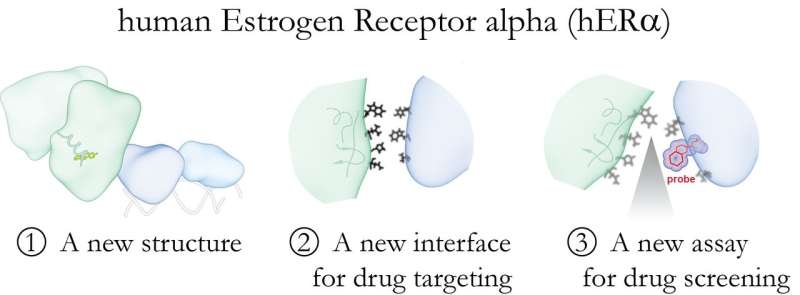New options for breast cancer drug development found in estrogen receptors

Many breast cancer drugs block estrogen receptors inside cancer cells. Blocking the receptors early in disease progression staves off metastasis. But most patients with advanced disease eventually develop drug resistance, leaving doctors desperate for alternatives. Now, researchers from Case Western Reserve University School of Medicine have uncovered a previously uncharacterized, bridge-like structure within the human estrogen receptor that could serve as a valuable new drug target. In Nature Communications, researchers describe a "burning the bridge" strategy to disrupting the estrogen receptor, and how to screen breast cancer drugs designed to do it.
"Until now, the structure of the entire estrogen receptor complex was unknown, so it was a challenge to identify novel or functionally important target sites for new drugs," said Sichun Yang, Ph.D., senior author on the study and associate professor of nutrition, proteomics, pharmacology, and biophysics at Case Western Reserve University School of Medicine. "The structures of individual receptor pieces were known, but how they fit together was a mystery. Our study identified a novel interface that bridges the two major functional units of the receptor."
The "bridge" identified in the new study links two key receptor parts: one that binds estrogen, and one that attaches to DNA and controls genes in response to estrogen levels. Drugs that disrupt the bridge could affect how the two portions are able to work together, inhibiting receptor function. Said Yang, "Disruption of the bridge prevents the two major parts of the estrogen receptor complex from communicating, so targeting this interface represents a 'burning-the-bridge' strategy for drug discovery."
Yang, who is also a member of the Case Comprehensive Cancer Center, and colleagues integrated genetic engineering, proteomics, and computer modeling to reveal the full estrogen receptor structure. It is the first application of an approach the researchers developed and termed iSPOT (integration of Scattering, footPrinting, and dOcking simulaTion). The study was a collaborative effort between Case Western Reserve, Argonne National Laboratory, and Lawrence Berkeley National Laboratory. Yang led the study alongside Case Western Reserve colleagues Hung-Ying Kao, Ph.D., professor of biochemistry, and Mark Chance, Ph.D., vice dean for research and Charles W. and Iona A. Mathias Professor of Cancer Research.
The new study further suggests that the bridge can be exploited as a novel drug target. By genetically engineering fluorescent probes to normal receptors in their laboratory, Yang's team was able to tell when the two critical parts of the receptor were communicating properly. The set-up represents a new assay to screen small molecule drugs designed to therapeutically inhibit estrogen receptor function inside cancer cells.
"The assay works like a fuel gauge," Yang explained. "A full tank, or high fluorescence under the microscope, means the bridge interface is normal. If the reading drops to half a tank or empty when we add a drug molecule, it means the interface has been disrupted, and the molecule is a candidate for further analysis in cell-based experiments."
Already the researchers have begun to test drug molecules using their new assay. They also plan to screen libraries of drugs already FDA-approved. "This approach can jump-start drug discovery, by identifying drugs that can be re-purposed to target breast cancer," Yang said. Moreover, since the receptor has structural similarities to other hormone receptors central to ovarian, prostate, and endometrial cancers, the new study and the assay could have widespread implications for drug discovery.
"Employing our iSPOT technology, we have achieved medium to high-resolution structural models of the estrogen receptor for which no structure was previously available. We hope this will provide a roadmap to study receptor function and test new medications going forward," said Yang.
More information: Wei Huang et al, Multidomain architecture of estrogen receptor reveals interfacial cross-talk between its DNA-binding and ligand-binding domains, Nature Communications (2018). DOI: 10.1038/s41467-018-06034-2




















